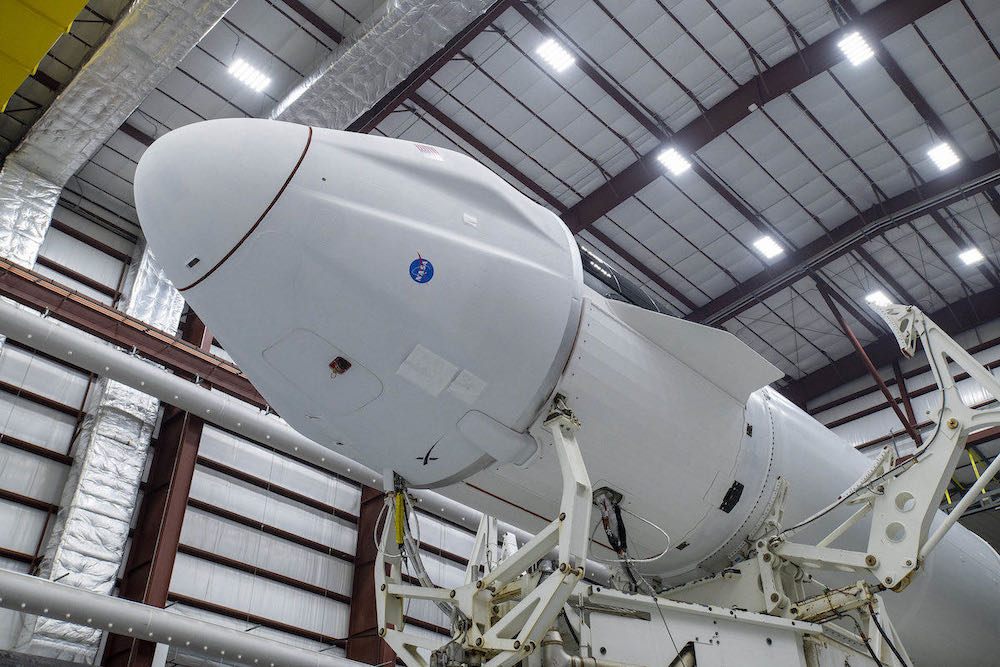EDITOR’S NOTE: Updated after the Falcon 9 static fire at 9 p.m. EDT (0100 GMT).
On the cusp of ending a two-month SpaceX launch drought, ground crews raised a Falcon 9 rocket vertical Wednesday on its launch pad at NASA’s Kennedy Space Center for an engine test-firing and final cargo loading before liftoff Saturday on a resupply flight to the International Space Station.
SpaceX rolled the Falcon 9 rocket, powered by a reused first stage booster, out of its hangar near pad 39A at Kennedy late Tuesday night. Then teams raised the launcher vertical on the seaside complex Wednesday.
The Falcon 9 rocket and its Cargo Dragon payload, standing 215 feet (65 meters) tall, ran through a practice countdown Wednesday evening. SpaceX’s launch team loaded densified, super-chilled kerosene and liquid oxygen into the two-stage rocket and lit its nine Merlin 1D main engines for 10 seconds at 9 p.m. EDT Wednesday (0100 GMT Thursday) for a pre-flight test-firing.
Assuming engineers find no concerns in a post-test data review, SpaceX is expected to clear the automated cargo mission for launch at 3:37 a.m. EDT (0737 GMT) Saturday. It will be the company’s 21st Falcon 9 launch of the year, and the first since June 30, an unusually long gap between SpaceX missions, at least in recent history.
SpaceX has paused launches of its Starlink internet satellites to complete development of new laser link terminals designed to allow the spacecraft to beam broadband signals to one another in orbit. The Starlink missions made up the lion’s share of the Falcon 9 launches in the first half of the year.
The Starlink launches are scheduled to resume in September from Vandenberg Space Force Base in California.
With an on-time launch Saturday, the Cargo Dragon capsule, recycled from a previous cargo mission in December, is scheduled to dock with the space station at 11 a.m. EDT (1500 GMT) Sunday with several tons of supplies and experiments.
Ground teams will load time-sensitive cargo into the Dragon spacecraft ahead of Saturday morning’s launch attempt.
Besides fresh food and spare parts, the Cargo Dragon is set to deliver an array of technology demonstration, materials science, and biomedical experiments to the space station.
They include a small robotic arm from GITAI Japan Inc., a Japanese company, to demonstrate in-space tasks that could lead to development of future robots to assist astronauts on long-duration space missions. The arm will run through its demonstrations, including switch and cable operations and in-space assembly experiments, inside the commercial Bishop airlock owned Nanoracks.
Some of the tasks will be autonomous, while others will be tele-operated from Nanoracks’ facility in Houston, according to GITAI.
“This technology demonstration is to show the world that the capabilities necessary for automation in space are finally available,” said Toyotaka Kozuki, GITAI Japan’s chief technology officer, in a statement. “It provides an inexpensive and safer source of labor in space, opening the door to the true commercialization of space.”

The mission also carries an experiment hosting package called the Faraday Research Facility. Developed by a Houston company named ProXops, the facility will be inserted by astronauts into one of the space station’s science racks.
On this flight, the facility carries an experiment from Houston Methodist Research Institute to test an implantable, remote-controlled drug delivery system. Scientists say the experiment could offer an alternative to bulky infusion pumps to help treat chronic conditions in patients on Earth.
NASA says facility also hosts two educational experiments to be performed on the space station, including one with participation from a Girl Scout troop on the ground.
There are also multiple CubeSats stowed inside the Cargo Dragon’s pressurized compartment. They will be robotically deployed outside the space station in the coming weeks and months.
The mission set for launch Saturday will be SpaceX’s 23rd commercial resupply flight to the space station since 2012, and the third to use a new generation of SpaceX Dragon cargo ships based on the company’s human-rated crew capsules.
NASA has multibillion-dollar contracts with SpaceX, Northrop Grumman, and Sierra Nevada Corp. to transport cargo to and from the space station.
A launch weather forecast issued Wednesday by the U.S. Space Force’s 45th Weather Squadron suggests a chance of scattered rain showers along Florida’s Space Coast early Saturday.
There is a 40% probability that weather might prevent launch Saturday morning, according to the outlook. The primary concerns are with cumulus clouds that could create a risk for lightning, and precipitation along the Falcon 9 and Cargo Dragon flight path.
There is a 30% chance of weather preventing launch during a backup launch opportunity Sunday.
Email the author.
Follow Stephen Clark on Twitter: @StephenClark1.
